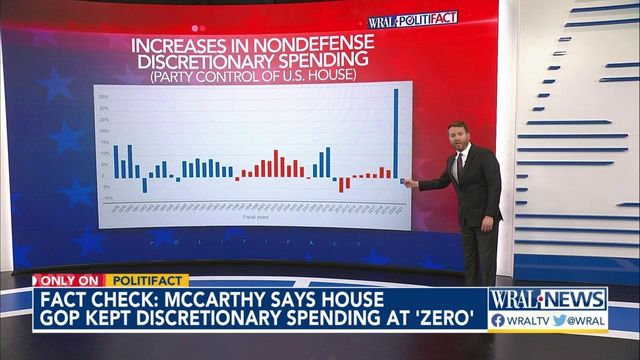Fact check: McCarthy says House GOP kept discretionary spending to 'zero'
In a recent interview with Fox News host Sean Hannity, newly installed House Speaker Kevin McCarthy, R-Calif., touted his party’s record of fiscal restraint.
"When the Republicans were in power the last time for eight years, do you know how much discretionary spending increased in those eight years? Zero," McCarthy told Hannity Jan. 10. But when the Democrats "were in power for four years," McCarthy said, "they increased it by 30%."
This fact-check will focus on McCarthy’s claim about House Republicans’ spending record. Federal spending stemming from the recently ousted Democratic House majority is based on estimates that aren’t final.
McCarthy’s office offered supporting evidence for his statement. However, other metrics tell a different story — and whether any holding pattern in spending can be credited to House Republicans is a more complicated question than McCarthy lets on.
What is discretionary spending?
Federal spending can be broken into a few broad categories. There’s mandatory spending, such as Social Security and Medicare; these programs effectively run on autopilot without annual appropriations passed by Congress. Another type of mandatory spending is interest on the federal debt.
The federal spending beyond these categories is classified as "discretionary." Congress must appropriate it annually. One type of discretionary spending provides for U.S. military needs. The rest of discretionary spending is generally called "nondefense discretionary spending."
McCarthy’s office pointed us to data from the nonpartisan Congressional Budget Office showing annual outlays for discretionary spending. Mark Bednar, a McCarthy spokesperson, flagged the period from fiscal year 2011 to fiscal year 2019, when Republicans controlled the House.
McCarthy used a metric called "outlays," which refers to actual federal dollars out the door during a given year.
During that period, nondefense discretionary spending rose about 2%, from about $648 billion to $661 billion. Total defense and non-defense discretionary spending fell slightly, by less than 1%. (These figures are not adjusted for inflation.)
And during that period, non-defense discretionary spending increased at slower rates than in previous periods of House Democratic control and a previous run of GOP control during the 1990s.
By another measure, the decline in discretionary outlays as a percentage of gross domestic product was even greater. From fiscal year 2011 to 2019, nondefense discretionary spending decreased 26%, and total discretionary spending, including defense, fell by 28%.
Budget authority vs. outlays
An alternative way of examining the numbers — budget authority — may be more revealing, experts say.
When Congress passes a spending bill, that bill may appropriate funding that’s intended to be spent not just in Year One but in Year Two, Year Three, and so on. "Budget authority" refers to the total amount of funding approved in the first year, even if it won’t be spent until later.
How much money a particular Congress approved for years to come can better illustrate lawmakers’ intentions.
There can be "long lags in some programs between funding and spending," said Paul N. Van de Water, a senior fellow at the left-of-center Center on Budget and Policy Priorities. "To see who did what and when, it’s better to use budget authority, not outlays."
During the same eight-year period that McCarthy’s office cited, fiscal years 2011 to 2019, budget authority for nondefense discretionary spending rose about 29%, from about $511 billion to about $658 billion. That’s much higher than the 2% increase for outlays.
"Highly variable appropriations for things like disaster assistance … complicate the analysis of spending changes and trends," Van de Water said.
McCarthy cited years that included Democratic leadership in the White House, Senate
A more basic question that casts some doubt on McCarthy’s statement is the definition of "in power."
McCarthy used Republicans’ control of the House as his metric. However, the House alone does not set spending levels; it must reach agreement with the Senate and the president. Although the party controlling the House can use its leverage to negotiate lower spending levels, it cannot enact its preferences on its own.
For the eight-year period McCarthy cited, Barack Obama, a Democrat, served as president for the first six years, and Democrats controlled the Senate for the first four years.
The only time during the period McCarthy cited when Republicans had unified control of the House, the Senate, and the presidency was in 2017 and 2018, during Donald Trump’s administration. Those years set the spending for fiscal years 2018 and 2019. The record for discretionary spending in those two years was mixed: a relatively large increase in 2018 and a decline in 2019.
Steve Ellis, president of Taxpayers for Common Sense, a nonpartisan budget analysis group, cautioned that while discretionary spending is "a useful metric," it doesn’t address mandatory spending, which is a bigger driver of the federal debt.
Ellis added that McCarthy could have made a more persuasive, if more limited, argument that a "divided government can help with spending restraint" because intraparty negotiation can act as a check on spending.
Our ruling

McCarthy said, "When the Republicans were in power the last time for eight years, do you know how much discretionary spending increased in those eight years? Zero."
McCarthy’s claim is based on Republicans’ control of the House from 2011 to 2019. During that period, the increase in "outlays," or actual federal dollars out the door during a given year, was close to zero. However, McCarthy’s claim is wrong when considering appropriations approved in one year but intended to be spent in subsequent years. That measure, called budget authority, increased by about 29% in the same period.
McCarthy’s statement also ignores that the first six of the eight years he referred to included Democratic leadership in the White House, Senate, or both. So, the spending patterns during those six years were shaped by bipartisan negotiation, not by Republican preferences alone.
We rate the statement Half True.













